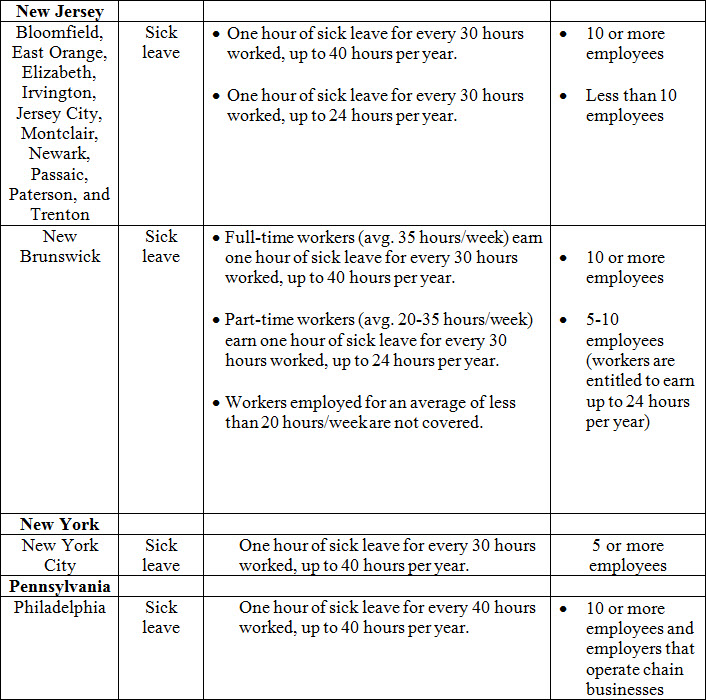Take two aspirin before reading further because apples won’t help. Keeping up with the ever-expanding paid leave laws is enough to give any employer a headache. Let’s start with those currently effective – 4 states, Puerto Rico, Washington D.C., and 22 other cities or counties:






Take two more aspirin and look ahead.
• The U.S. Department of Labor (“DOL”) is currently working on regulations mandating paid family and medical leave policies for all government contractors; those regulations are expected later this year.
• New York is set to phase-in the nation’s broadest paid leave policy starting in 2018. There, employees will be eligible for 8-12 weeks (as the plan is phased-in) of partially paid family leave (50%-67% of average weekly wages).
• Other states and localities have legislation in the pipeline. For example, Plainfield, New Jersey and Los Angeles, California passed paid sick time laws which go into effect July 2016. In Maryland, the Montgomery County Council passed a paid sick time law which will go into effect on October 1, 2016 while San Diego’s expanded paid sick time law was approved on June 7, 2016. Effective January 1, 2017, employers with employees in Santa Monica, Spokane, and Vermont will need to comply with the corresponding paid sick leave ordinances. San Francisco is adding paid parental leave,which will also be phased-in (according to number of employees) starting January 1, 2017. Chicago, Illinois has also enacted paid sick time which will go into effect July 2017.
For employers fortunate enough to be outside the realm of government contracting and with business operations confined to a single city (or at least a single state), the aspirin alert passes quickly. For those employers with a national scope, there is a dilemma: a single policy based on the most generous current law or a headache inducing manual with upwards of 25 (for today with that number increasing month by month) separate policies for each local facility.
Let’s consider what such a single policy approach might look like:
1. Front-load the maximum number of hours of sick time accruable into employees’ accounts on January 1.
a. This eliminates accrual method and carryover calculation discrepancies across jurisdictions.
b. Leave should be available for immediate use by current employees.
2. Front-loading 72 hours (9 workdays) of paid sick time generally complies with the highest required amount of paid leave. [NB: 96 hour requirements for the hotel industry due to certain city laws imposing more on those employers].
3. This policy must apply to full-time, part-time, and temporary employees. New hires are eligible to use paid sick leave on the 90th day of employment or upon 680 hours worked, whichever occurs first. This, however, works only for businesses that are not in either Puerto Rico (which requires only a 2 month waiting period before sick leave may be used) or Long Beach and SeaTac (which each allow employees to use paid sick leave as accrued).
4. Leave should apply to caring for a child, a parent, a spouse, a domestic partner, or any other individual related by blood or affinity whose close association with the employee is the equivalent of a family relationship who has a serious injury/illness or is otherwise in need of care; victims of: domestic violence, sexual assault, or stalking, or to relieve family pressure while a family member is called to active military service.
5. Payout of unused sick leave at years’ end (before front-loading the required amount of leave on January 1 for the next year) is required.
6. Accrued sick time can be used in the smaller of hourly increments or the smallest increment the employer’s payroll system uses to account for other absences or use of time.
7. Accrued but unused sick time is lost upon termination but must be reinstated for immediate use by an employee who is rehired within 1 year after separation.
Are you saying “where is that industrial-strength aspirin?” A single policy is no panacea. Indeed, implementing such a uniform policy, based on the most generous amount of sick time required, may also be cost prohibitive — providing 72 hours of paid sick leave up-front for even part-time and temporary employees upon their first day is too expensive a price for administrative convenience.
With the illusion shattered and with balancing too many local laws inducing migraines, you can write to your Senators and members of Congress. This explosion of local laws concerning paid leave perhaps begs for a federal solution: a single law that pre-empts all state and local laws. Interestingly, the U.S. is the only developed country without national legislation mandating paid leave.

